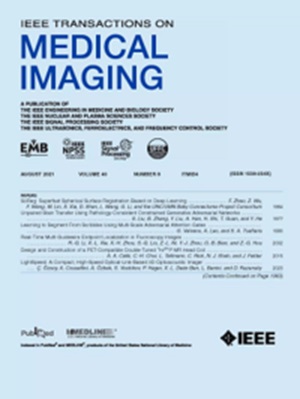子宫内扩散加权MRI相干引导下胼胝体的自动、年龄一致性重建
IF 8.9
1区 医学
Q1 COMPUTER SCIENCE, INTERDISCIPLINARY APPLICATIONS
引用次数: 3
摘要
通过子宫内扩散加权磁共振成像(MRI)重建胎儿大脑中的白质连接面临许多挑战,包括受试者运动、解剖规模小以及图像分辨率和信号有限。这些问题因需要在整个发展过程中跟踪结构连通性的重大变化而更加复杂。我们提出了一种基于流线束描记术中相干模式的几何形状的自动化方法,以提高不同胎龄的束提取的可靠性和完整性,并将其应用于胼胝体的重建。这种方法专门致力于解决胎儿大脑成像的挑战,避免了依赖纤维束造影图谱,并处理了受试者之间和不同年龄段发育中大脑的大小、形状和组织特性的变化。尽管子宫内MRI的束描记术通常存在大量误导和缺失的路径,但我们证明了提取胼胝体相干束的可行性,同时避免了不适当的转移到其他束中。本文章由计算机程序翻译,如有差异,请以英文原文为准。
Automatic, Age Consistent Reconstruction of the Corpus Callosum Guided by Coherency From In Utero Diffusion-Weighted MRI
Reconstruction of white matter connectivity in the fetal brain from in utero diffusion-weighted magnetic resonance imaging (MRI) faces many challenges, including subject motion, small anatomical scale, and limited image resolution and signal. These issues are compounded by the need to track significant changes in structural connectivity throughout development. We present an automated method for improved reliability and completeness of tract extraction across a wide range of gestational ages, based on the geometry of coherent patterns in streamline tractography, and apply it to the reconstruction of the corpus callosum. This method, focused specifically at addressing the challenges of fetal brain imaging, avoids depending on a tractography atlas, and handles variations in size, shape, and tissue properties of developing brains, both between subjects and across ages. Although tractography from in utero MRI generally suffers from a significant number of misleading and missing pathways, we demonstrate the feasibility of extracting the coherent bundle of the corpus callosum while avoiding inappropriate diversions into other tracts.
求助全文
通过发布文献求助,成功后即可免费获取论文全文。
去求助
来源期刊

IEEE Transactions on Medical Imaging
医学-成像科学与照相技术
CiteScore
21.80
自引率
5.70%
发文量
637
审稿时长
5.6 months
期刊介绍:
The IEEE Transactions on Medical Imaging (T-MI) is a journal that welcomes the submission of manuscripts focusing on various aspects of medical imaging. The journal encourages the exploration of body structure, morphology, and function through different imaging techniques, including ultrasound, X-rays, magnetic resonance, radionuclides, microwaves, and optical methods. It also promotes contributions related to cell and molecular imaging, as well as all forms of microscopy.
T-MI publishes original research papers that cover a wide range of topics, including but not limited to novel acquisition techniques, medical image processing and analysis, visualization and performance, pattern recognition, machine learning, and other related methods. The journal particularly encourages highly technical studies that offer new perspectives. By emphasizing the unification of medicine, biology, and imaging, T-MI seeks to bridge the gap between instrumentation, hardware, software, mathematics, physics, biology, and medicine by introducing new analysis methods.
While the journal welcomes strong application papers that describe novel methods, it directs papers that focus solely on important applications using medically adopted or well-established methods without significant innovation in methodology to other journals. T-MI is indexed in Pubmed® and Medline®, which are products of the United States National Library of Medicine.
 求助内容:
求助内容: 应助结果提醒方式:
应助结果提醒方式:


